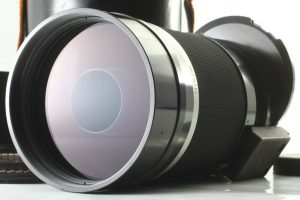
Whether you shoot film or digital, there are certain lenses that appeal to certain people. Some people like myself are more comfortable with wide angle lenses, some prefer portrait lenses like the Nikkor 85mm f/1.8 or the Summicron 90mm f/2, and some prefer long telephoto lenses.
For those who have a need to capture closeups of things far away, such as sports or wildlife photographers, you’re well aware that long lenses tend to get very heavy.
Nikon’s 800mm f/5.6 IF-ED AIS lens weighs a whopping 12 pounds, is nearly 2 feet long and isn’t even the longest or heaviest lens they make.
For the photographer who has a need for a very long lens, but needs something a little more portable, the reflex mirror lens was created to offer a long reach, but in a much smaller package. The proper name for mirror lenses is actually ‘catadioptric lenses’ which use a clever arrangement of mirrors and lens elements that bounce the light back and forth to achieve the same focal length that a standard lens might. The first use of catadioptric lenses dates back to the early 1800s when the concept was used in early lighthouse reflectors. Over the next 100 years, the concept was used in telescopes and other optical products.

Mirror lenses as they were more commonly called have the benefit of being both shorter, and in most cases (but not all), lighter. Their biggest downside however is that they’re usually not very fast, with many having maximum apertures of f/8 and smaller, and because of the design of the lens, lack adjustable irises meaning the maximum aperture is often the only aperture. Neutral density filters are commonly used to stop down, or decrease the amount of light that enters a mirror lens. Depending on your tastes, another characteristic of mirror lenses is that they make donut shaped “bokeh” in out of focus details, which may or may not be appealing to some.
The illustration in the short article below from the August 1968 issue of Modern Photography shows the light path between two sample 500mm lenses.
The first mainstream mirror lenses were produced in the late 1950s. Nippon Kogaku’s 1000mm f/6.3 Nikkor Mirror lens was the first mirror lens produced in Japan and showed a commitment by Nippon Kogaku to produce lenses used by professional photographers. It was an incredibly well built and heavy lens and remained the fastest mirror lens for at least a decade after it’s release.
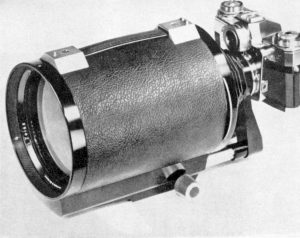
The first article below is from the August/September 1963 issue of Camera 35 and does a good job introducing the concept of a catadioptric lens, giving a little bit of history into what the design does. It shows a couple images of other lenses such as the Zeiss Mirotar 500 f/4.5.
In their analysis of both Nikkor 500mm and 1000mm lenses, they equate the actual opening of the “iris” of the two lenses to be 4 and 6.5 inches! Imagine the glass elements that would be required to create a standard 1000mm lens with a 6.5 inch iris opening!
Even wilder are a series of Zoomar mirror lenses, that frankly, I had never even heard of before reading this article with focal lengths from 20 inches (500mm) to 150 inches (3800mm), the largest of which has a minimum focus distance of 350 feet and a hyperfocal distance of 7 miles! The price? Well, for the privilege of shooting such a monstrosity, back in September 1963 you’d have to shell out $3500, which when adjusted for inflation compares to $29,426.79 today. Ouch!
This next article is from the March 1970 issue of Modern Photography at a time when mirror lenses were no longer new and a variety of inexpensive alternatives were on the market. This one is far less educational and compares high quality lenses like the 500mm f/4.5 Zeiss Mirotar and 500mm f/8 Reflex-Nikkor to bargain lenses produced by unnamed Japanese and Russian companies.
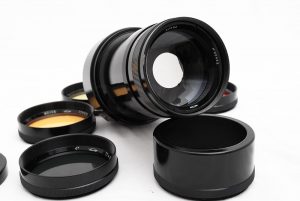
One of the lenses, simply called the Russian MTO lens is the one I was most interested about. Further research into what’s called the MTO lens is most likely a lens originally made for the Zenit SLR in M39 mount called the 3M-5A-MC. Using a design created by the Russian optical engineer Dmitry Dmitrievich Maksutov for telescopes, the lens gained early recognition for it’s sharpness and lacking of aberrations common in other catadioptric designs.
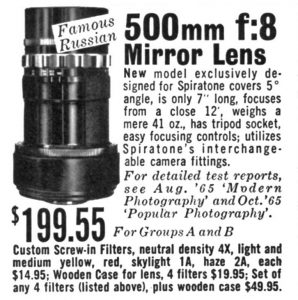
In the mid 1960s, the US importer Spiratone would sell these “Famous Russian” lenses adapted with the universal T-mount which could then be adapted to pretty much any SLR mount at the time. Selling at a price of $199.55 for the lens and an additional $49.95 for a custom wooden case plus 4 filters, Spiratone’s lens was an affordable option for those wanting to try such a lens without the investment required for Nikkor or Zeiss lenses.
If you’d like to know more about these Russian MTO lenses, there are two excellent discussions with more history and samples comparing the results from one to several other mirror lenses at these two articles on Photo.net.
https://www.photo.net/discuss/threads/maksutov-lens-mto-500mm-f-8.478198/
https://www.photo.net/discuss/threads/what-is-this-russian-lens.475650/
All scans used with permission by Marc Bergman, 2020.


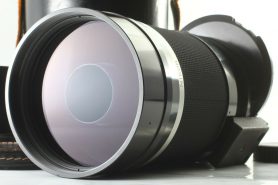
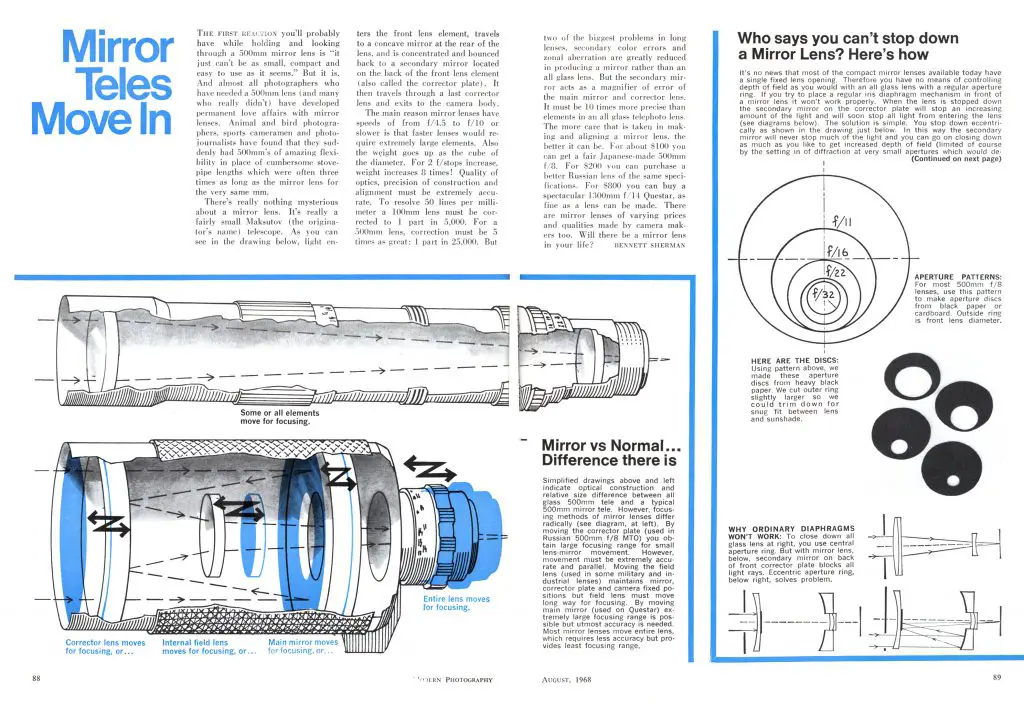
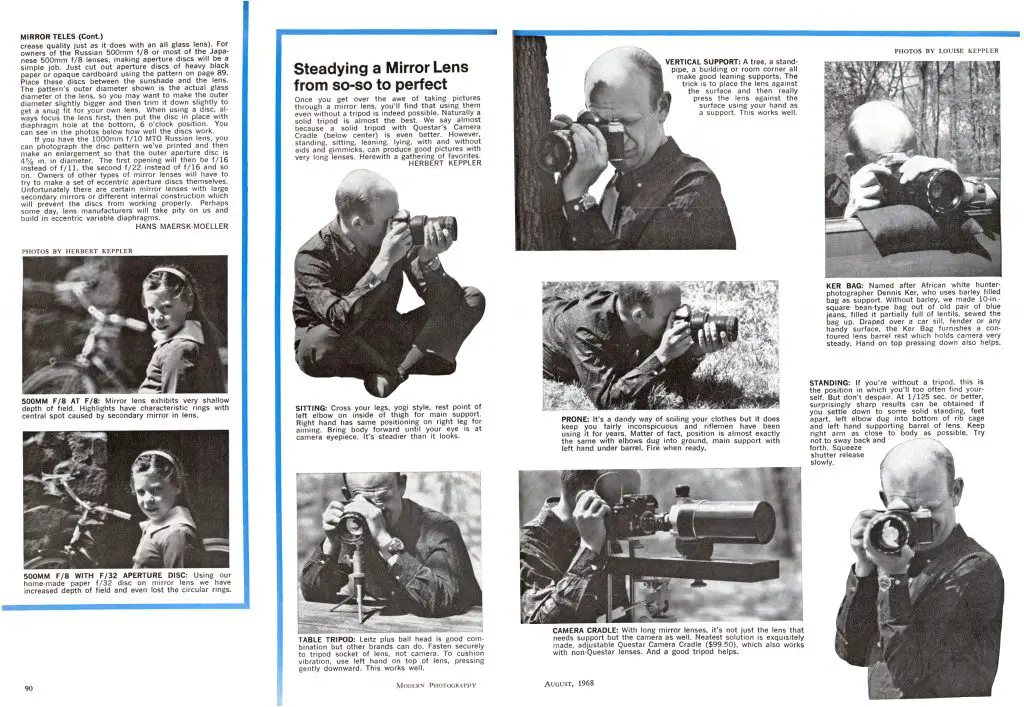
I have a Spiratone mirror lens for my Olympus OM-1. It’s not great. But if I really need to see something two miles away it does work.
I have one too, but I think there is something wrong with it, because no matter what I set it to, nothing is ever in focus. It gets close, but it feels like something is off internally. It was included in a lot of other things though so I wasn’t too bothered by it. I won’t deny though that I would like one day to be able to try a good example of a mirror lens. I just refuse to pay the asking prices for nice ones, considering how rarely I’d use it.
I read about the Russian MTO lens then went on to other things. (Pushing Tri-X Pan in Diafine, using Kodak’s ESP processing to get High Speed Ektachrome to E.I. 400, trying out Anscochrome/GAF 500.) The National Geographic ads for Questar telescopes were intriguing, but I went back to the 200mm f/4 Nikkor. Then Spiratone’s Japanese 500mm f/8 Mirror lens arrived, and I bought one.
Ye Olde Welt/Safelock FL Tripod was too light for a Nikkormat + 500mm mirror lens, so I moved up to a (somewhat) sturdier PT3. (PT4!)
Then, atmospheric conditions that didn’t bother a 200mm lens became pronounced in a 500mm lens. Long distance photography became an exercise is avoiding “shimmering heat waves.’
Finally, no depth of field. Pinpoint focus or mush. Then “doughnut hole bokeh” went from novelty to “can I avoid that, somehow?” I tried the off-center/lens cap Waterhouse stop thing to increase depth of field, but all I got was more camera shake.
Which film works best with such a long lens? Tri-X Pan was OK, if you didn’t mind grain. Plus-X Pan would do “if conditions were perfect.”
Eventually I put it aside and looked for a “long focus lens,” winding up with a 2-piece 600mm f/5.6 Nikkor. (I should have gotten a heavy duty Bogen or a Welt-Safelock PT4 tripod instead of overloading that medium weight PT3.)
As you, Mike, I’m more inclined to standard and w/a shooting + a 90mm, but that didn’t stop me from trying out a mirror lens. Well, I had an slr and the lure was great, wasn’t it? That’s when I discovered that there was no way I could handhold it. So quickly back to what I was happy shooting with. Any reduction in size and weight over a conventional 500mm tele would be outweighed by having to carry around a tripod.
My big regret, though, was turning down the opportunity to acquire the rare Rokkor 250mm lens a few years ago at what would turn out to have been a bargain, just £200. Look what this little lens seems to sell for today.
Terry, mirror lenses are a type of lens that logically I know I won’t shoot often. For one, I just don’t need super long telephotos in the style of photography I mainly shoot, but with challenges in portability plus the increased difficulty in shooting hand held, it’s just not something I’ll do often. Yet, I still find myself drawn to these lenses. I would love one of the Nikkor or Minolta mirrors, or even that Russian MTO lens, but just am not willing to spend the money required for a nice one, considering how rarely I’d use it.
Owned a Russian MTO 500mm f8 for a while; used it with an M42/PK adapter on a K1 body. Sharp as the proverbial tack with a depth of focus seemingly measured in millimeters. Found it impossible to follow-focus moving targets with this beast and sold it. Had more success using a manually-focused 300mm with auto diaphragm stopped down to f11 or f16, coupled with a high ISO rating on the K1.
Hello,Thank you so much for a really Informative and interesting read. I have a 500mm f8 reflex Nikkor which I have been using for some years on my D500, and I love it. Used in the right conditions it produces some great results, in my humble opinion. I hope it’s alright to share this link on my blog https://arhphotographic.wordpress.com/2019/01/22/redwings/. The third image was taken with the 500mm, you can see the familiar ‘donuts’ in the back ground, delicious!
Andrew
I’m surprised I missed this last year when published. I’m a mirror lens enthusiast with over a dozen of them. It started with a search for a longer lens and not liking the options aside from very expensive ones. I reluctantly tried a mirror and fortunately, chose well. Despite the donut bokeh and focusing challenges, I very much enjoy using them. There are five that I use more than any others; Rubinar 5.6/500, Minolta AF Reflex 8/500, Minolta Vectis 8/400, and Tamron SP 5.6/350. All are very good lenses.
I found it much more difficult or near impossible when using a DSLR but when I switched to a mirrorless with electric viewfinder and focus magnification, it was a game changer. Technique is very important to succe3ss and it takes a while to develop. I can handhold but mostly use a monopod for 500mm and above. I should also note that the light is very bright where I live.
For sure, not all mirrors are the same. There is a big difference in ease of focusing with the better lenses. I’m happy to answer questions if I can help others avoid mistakes or in choosing the better lenses. Many of my mirror images can be seen here and each image is tagged with the lens used: https://www.flickr.com/photos/103713015@N06/albums/72157708914494981
Mike, thanks for the insight! You’ll likely be interested to know that in October, I will be posting a review of the MTO 500 that I mentioned in this article. Since posting it, I picked one up in it’s original wooden box with all the filters and am putting it through it’s paces both on film and digitally.
Like you pointed out, they’re MUCH easier to use on mirrorless with electronic viewfinders, and with some sort of stabilization. Lots of fun though and I’ll definitely check out your flickr page!
Mike: Within the MTO line, there are multiple versions and not all are equal. I think they’re all good, which is more than I can say about the made-in-Japan mirrors. There is a 5.6/300mm, model MC3M-7K that may rival the Tamron SP 350. From my experience, the 3M-6A (or ZM-6A) is the best of the MTO. It is also necessarily bigger due to the increased speed. There are also the Rubinar mirrors with fewer models and among those, the 5.6/500 is clearly the superior, but there is also a highly touted 4.5/300 with a price to match.
There may always be some copy variance but with mirrors, the focusing creates the biggest challenge when making comparisons. I wish you good luck getting perfectly focused images from a film camera. I will look forward to seeing your report in October.
Regards,
Mike Lempert